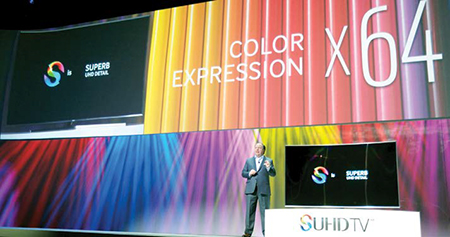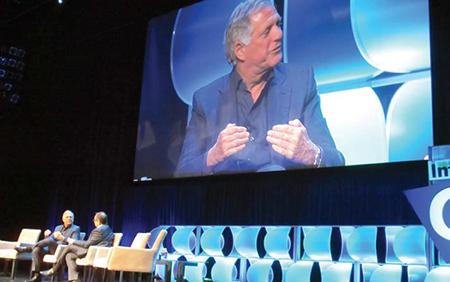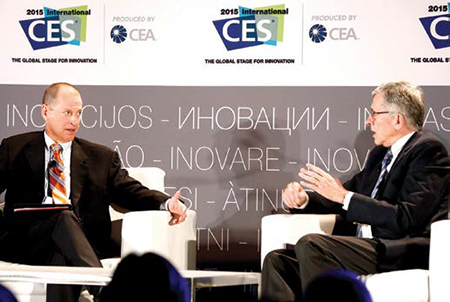Cars Supplant TVs at CES
LAS VEGAS—When Panasonic’s booth has nearly as many smart cars as new TV models and at Sony’s booth, barely 20 percent of the floor space is devoted to TV technology, you know that changes are afoot.
When 12 TV set-makers, studios and technology suppliers agree to team up for anything, you can bet that it’s not about “business as usual.”
And when flying drones and tiny sports-cameras become key ingredients in the “media mix,” you can be sure that upheavals in the television world are accelerating beyond expectations.
Blend in a few headlines—spectrum policy predictions, competing operating systems for smart TVs, a $20 a month streaming service anchored by ESPN aimed at cord-cutters—and your head is swirling. You are in the midst of the 2015 International CES, where the broadcasting industry’s big issues become but a cog in the evolving technology and consumer video ecosystem.

At the 2015 International CES, Samsung showcased its next-generation devices and services, led by an 88-inch SUHD TV and Samsung’s Milk VR virtual reality video service.DISPLAY TECHNOLOGY
With a record-setting crowd of more than 170,000 attendees (final audited figures will be released in April), the 2015 CES carried significance far beyond the curved and shape-shifting monitors (obviating the term “flat” panel), the omnipresent Ultra High Definition-4K promotions and the growing role of streaming media.
As the dozens of major video exhibits confirmed, skirmishes over format and technology for TV displays will continue indefinitely. There are also the inevitable business efforts to cover all bets. For example, LG—among the strongest proponents of OLED displays—also showcased (albeit quietly) its evolving Quantum Dot technology, which was also supported by Sharp, Samsung and others.
And then there’s the TV operating system skirmish. Samsung unveiled TV sets (along with portable devices) built around its Tizen operating system, which is not necessarily compatible with LG’s WebOS, Google’s Android or any of the smart home platforms that were part of the omnipresent “Internet of Things” (or “Internet of Everything” as Qualcomm and Cisco prefer to describe their interconnectivity ecosystems) at CES.
The professional video industry's #1 source for news, trends and product and tech information. Sign up below.
In addition to the ongoing OLED versus LCD face-off (see “Displays Get Bigger and Brighter at 2015 CES, “ p. 12), the never-ending feature-creep continues. With curved screens now commonplace, TV makers are pushing “flexible” (LG’s term), or “bendable” (Samsung’s version) screens that can be moved from flat to concave. (Panasonic demonstrated a similar technology last year.)
Although almost every major TV maker showed curved displays in all sizes at CES, the appeal of the format is still sketchy. Steve Koenig, director of industry analysis for show sponsor Consumer Electronics Association, said that curved screen worldwide sales amounted to just under one million units last year and will reach about 3.4 million unit sales this year. In his global analysis, Koenig also predicted that OLED, while attracting plenty of attention, will need at least five years—until 2020—before prices fall sufficiently for widespread adoption.
At the same time, the Ultra HD juggernaut continues, with signs that despite the rosy optimism for 4K UHDTV, there may be alternatives coming from several directions: advanced 4K, 8K and High Dynamic Range (HDR) imaging.
BIG VISIONS FROM THE UHD ALLIANCE
For example, the UHD Alliance, which debuted at CES, calls itself a coalition of “film studios, TV brands, content distributors, post-production and technology companies that aim to create a unified criterion for premium UHD platforms, from devices to content including next generation features like as 4K resolution, High Dynamic Range, Wide Color Gamut, High Frame Rate and Immersive Audio.” The alliance’s stated goals are “to ensure that all of the links in the chain—from the production, distribution and consumption of content to the playback capability of devices—meet the premium quality standards, whilst embracing options that are open and allow flexibility in the market.”
With that lofty agenda, the companies— not always known for friendly collaboration— face a daunting assault on the big issues of UHD. Initial alliance members include DirecTV, Dolby Laboratories, LG Electronics, Netflix, Panasonic, Samsung, Sharp, Sony, Technicolor, Disney, Twentieth Century Fox and Warner Bros. Entertainment.
The alliance’s announcement was accompanied by endorsements from members in various business sectors:
“As the UHD environment continues to evolve, we are strengthening our commitment to high-quality UHD content and devices,” said Hyunsuk Kim, president, Visual Display Business at Samsung Electronics. “The Alliance will encourage the development of high-quality UHD content while distinguishing TVs that provide the most premium UHD viewing experience.”
As an example of the hurdles to be faced, during CES, Dolby and Warner Bros. unveiled a partnership that includes a slate of 4K titles mastered in Dolby Vision, an HDR format from Dolby that is not quite consistent with UHD. At a Media & Entertainment Services Alliance (MESA) session at the show, Roland Vlaicu, senior director of broadcast imaging at Dolby Labs, said that Warner is just one of several new content partners which include Amazon, Netflix, Vudu and Xbox Video, who are all looking to incorporate Dolby Vision.
“The dynamics are that in Hollywood, one company has to move first before the rest come on board,” he said. Now that Warner is in the Dolby Vision fold, Vlaicu expects others to follow.
Dolby has also teamed up with Hisense, TCL, Philips and Toshiba to build TV sets with embedded Dolby Vision technology. (The deal with Toshiba may be irrelevant since that Japanese mainstay did not show any new TV monitors at CES, hinting—but not confirming—its plans to exit the retail TV business. Toshiba’s booth was filled with wearable glasses, underlying technology plus a karaoke-singing android/robot.)
Moreover, the definition of HDR is still a work in progress. Some manufacturers contend that 740–800 nits of brightness is sufficient, while others cite somewhere between 1,000–2,000 nits. Dolby itself has said 4,000 nits are needed for the full Dolby Vision experience.

MediaLink CEO Michael Kassan interviewed CBS President Les Moonves about the network’s OTT initiatives.BEYOND DISH’S $20 STREAMING DEAL
Sling TV, a new streaming video service aimed at cord-cutters, drew some of the biggest “wows” at the show. Satellite company Dish, which has been buying spectrum and exploring broadband ventures, revealed plans to offer a $20 per month Sling TV service that will include popular channels from Disney Turner and Scripps Networks, including ESPN, ESPN2, TNT, TBS, CNN, Food Network, HGTV, Cartoon Network and Disney Channel. A “Kids Extra” add-on will include Disney Junior, Disney XD, Boomerang, Baby TV and Duck TV, while a “News & Info Extra” add-on will feature HLN, Cooking Channel, DIY and Bloomberg TV. The service will also offer VOD plus original content from Disney-owned Makers Studios.
The service, expected to go live by early Spring, will be accessible via numerous over-the-top receivers, including Amazon Fire TV, Amazon Fire TV Stick, Google Nexus Player, select LG Smart TVs, Roku players, Roku TV models, Samsung Smart TVs, Xbox One from Microsoft, iOS, Android, Mac and PCs.
The surprise Dish announcement was one of many streaming media initiatives unveiled at CES. Netflix introduced its “smart TV certification program,” which allows TV makers—starting with LG, Sharp, Sony, Vizio and Roku TV makers (Hisense and others)—to put a “Netflix Recommended TV” label on their receivers.
Samsung said it would expand its “Milk” multimedia service, including plans to include virtual reality module along with music and video services.
Meanwhile, the wireless potential for streaming became clear when Verizon CEO Lowell McAdam announced plans to introduce a “mobile-first” over-the-top service with 20 to 30 channels by autumn of this year. Speaking at a private financial conference in Las Vegas, McAdam said that the venture will be separate from Verizon’s FiOS TV business.
Streaming also raises the challenge of content discovery and navigation. LG claims that its webOS 2.0 platform allows for easier multitasking as well as access to all of a consumer’s content in one user interface. In an interview with Beet.TV on the show floor, Matt Durgin, LG’s director of Smart TV Content, explained that, “consumers can seamlessly switch from source to source. You can go from Netflix to Amazon to ESPN to HBO and back.”

CEA President Gary Shapiro interviewed FCC Chairman Tom Wheeler. Several CES speakers addressed the growing problem of finding content across traditional linear TV and the unlimited OTT program inventory. It’s an ever-greater challenge to viewers, according to Mark Jeffery, Ericsson’s senior director of technical strategy- Mediacom. At a CES panel on next-generation OTT video, Jeffery noted that program suppliers have no incentive to create a unified search and discovery experience.
“There’s a discrepancy between what the user wants and what the video distributor wants,” he said. Multichannel video program distributors are in the best position to develop such cross-platform search capabilities, unlike content providers who do not want to let viewers seek content that is beyond their own libraries.
STREAMING RAISES ITS PROFILE
Seventy percent of broadband users now stream content regularly while only 55 percent of “Millennials” (ages 13 to 34) watch TV as their “main source of content.” Those two factoids emerged from a study unveiled at CES; CEA and NATPE supported the research, which was conducted by E-Poll Marketing Research, a Los Angeles-area firm that specializes in media consumption. The findings echoed other recent studies from Deloitte, ABI, comScore and other researchers about the growing acceptance of streaming video services.
“Our study confirms that the paradigm for TV content discovery has changed dramatically with increased availability and use of TV content streaming options,” said NATPE President/CEO Rod Perth. “With more than seven in 10 viewers in broadband households having streamed full-length TV programs in the past six months, there are opportunities for networks and content producers to reach and build audiences.”
The study found that millennials are significantly more likely to watch TV programs from a streaming source (84 percent said they streamed in the past six months), compared to live TV programming (54 percent), or time-shifted content from a DVR (33 percent). Gen Xers (35-50 year-olds), were the heaviest users of pay-TV time shifted offerings, including VOD and DVR, with 76 percent using their VOD service once a week or more often.
MOONVES’ OTT MOMENT OF TRUTH
CBS Corp. CEO Les Moonves described why an “old school guy” like himself— a legendary cheerleader for traditional broadcasting—was wooed to the streaming opportunities that his network recently announced. In an on-stage discussion with MediaLink CEO Michael Kassan, Moonves explained that the CBS Interactive team demonstrated the demand for CBS programs, including NFL games, via IP devices.
“It was the realization that there are 10 million broadband-only homes,” Moonves said. “This over-the-top offering enables everyone to watch our shows wherever. We don’t care where you watch our content or when you watch our content.”
SECOND-SCREEN SHIFTING DIRECTION
“Second-screen” and “social TV” applications (usually tablet or mobile handset content wedded to TV programming), have faced challenges in recent months, primarily because of companies dissolving or merging: TVtag (formerly GetGlue) closed its doors at the end of 2014, months after its merger with i-Tag. Earlier in the year another social viewing app Zeebox rebranded itself as “Beamly” to focus on celebrity gossip.
ConnecTV, another second screen pioneer, has abandoned its simul-TV model and is now enabling “video memes.” Viewers can clip TV shows and insert their own comments onto the clip. Stacy Jolna, the companys chief marketing officer told TV Technology that the first question he always gets is “What about copyright?” but he says that the application is considered “fair use.” Visit www.connectv.com/help/make-a-clip to learn how to create a “video meme.”
POLICY-MAKING AS USUAL
FCC Chairman Tom Wheeler generated headlines with his staunch expectation that broadcast spectrum auctions will begin as scheduled in early 2016 and his hints that the FCC will adopt Title II (utility-like) regulation for net neutrality.
In his second annual on-stage conversation with CEA President/CEO Gary Shapiro, Wheeler said he expects to confirm that spectrum auction timetable by June. When Shapiro cited the broadcast industry’s “crazy lawsuit” to postpone or stop the auction, Wheeler deemed it “without merit.” He also emphasized that “the future of the spectrum is spectrum sharing,” referring primarily to use of airwaves among many different types of services.
As for net neutrality, Wheeler indicated that the commission will vote on Feb. 26 about the plan, which was expected to be circulated among commissioners early this month. Although he did not specify details of the plan, Wheeler indicated that it would take a “just and reasonable” Title II (utility-like regulation) approach with extensive forbearance that would provide exceptions for specific uses. He said that the rules would preclude blocking and paid prioritization, but he noted that sometimes “priority makes a whole lot of sense.” In a nod to the expansive displays of wireless and mobile technology in the exhibit halls, Wheeler said, “Wireless is what your floor is all about… we’ll spend the next 50 years trying to figure out… how to adapt and adopt to the new realities” of the wireless ecosystem.
WARNINGS ABOUT ‘SMARTHOME HACKING’
With smart TVs becoming a likely interface for controlling many of the devices that will be connected via “Internet of Things” technology, Federal Trade Commission Chair Edith Ramirez issued a warning at a CES session featuring top government regulators, cautioning that all the connected tools will come with privacy challenges.
“We have… been warned that 2015 will be the year we start hearing about smarthome hacking,” Ramirez said. “These predictions highlight the complexity of the IoT... enormous benefits.... [but] significant privacy and security implications.”
“Your smart TV and tablet may track whether you watch the History Channel or reality television, but will your TV-viewing habits be shared with prospective employers or universities?” she asked. Reflecting ongoing FTC examinations of “data brokers,” Ramirez voiced concern that information viewers unknowingly put into the system will enable outsiders (such as advertisers) to “make decisions about whether you are shown ads for organic food or junk food.”
She emphasized that IoT systems—even more than computers and mobile devices— have entry points that are open to attack. She said that vendors behind the IoT concepts have not sufficiently protected their devices from security breaches.
With so many opportunities and distractions, this year’s CES—moreso than most in recent years—demonstrated an overhaul that is reshaping the media landscape. It’s not just about devices anymore, but the ways in which they are being deployed for new productions. Unfortunately, there is not yet any roadmap for this evolution, and smart cars are not yet ready to travel into this uncharted media world.
Gary Arlen, a contributor to Broadcasting & Cable, NextTV and TV Tech, is known for his visionary insights into the convergence of media + telecom + content + technology. His perspectives on public/tech policy, marketing and audience measurement have added to the value of his research and analyses of emerging interactive and broadband services. Gary was founder/editor/publisher of Interactivity Report, TeleServices Report and other influential newsletters; he was the long-time “curmudgeon” columnist for Multichannel News as well as a regular contributor to AdMap, Washington Technology and Telecommunications Reports; Gary writes regularly about trends and media/marketing for the Consumer Technology Association's i3 magazine plus several blogs.

